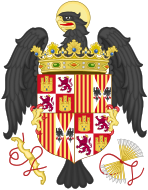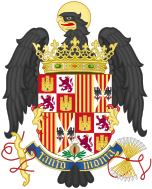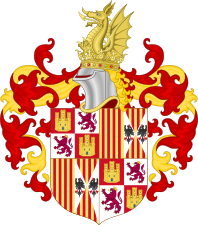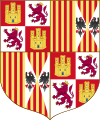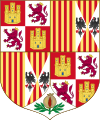Ferdinand II of Aragon facts for kids
Quick facts for kids Ferdinand II of Aragon |
|
|---|---|
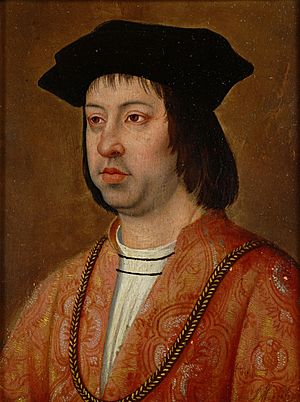
Portrait by Michael Sittow
|
|
| King of Aragon (more...) | |
| Reign | 20 January 1479 – 23 January 1516 |
| Predecessor | John II |
| Successor | Joanna |
| King of Castile and León (jure uxoris) (as Ferdinand V) |
|
| Reign | 15 January 1475 – 26 November 1504 |
| Predecessor | Isabella I |
| Successor | Joanna |
| Alongside | Isabella I |
| Born | 10 March 1452 Sos, Aragon |
| Died | 23 January 1516 (aged 63) Madrigalejo, Extremadura |
| Burial | Royal Chapel of Granada |
| Spouse | |
| Issue Detail |
|
| House | Trastámara |
| Father | John II of Aragon and Navarre |
| Mother | Juana Enríquez |
| Religion | Roman Catholicism |
| Signature |  |
Ferdinand II (born March 10, 1452 – died January 23, 1516) was a very important king in Spanish history. He ruled the Kingdom of Aragon from 1479 until his death. He was also the king of Castile from 1475 to 1504. He became king of Castile because he was married to Queen Isabella I of Castile.
Ferdinand and Isabella ruled together over a united Spain. They are famously known as the Catholic Monarchs. Many people see Ferdinand as the first true king of Spain. However, Castile and Aragon were legally separate kingdoms until much later.
When Ferdinand became king of Aragon in 1479, his lands included Aragon, Valencia, Majorca, Sardinia, Sicily, and principality of Catalonia. His marriage to Isabella I of Castile was a key moment for the Spanish monarchy. Together, they played a huge part in the European colonization of the Americas. They sponsored Christopher Columbus's first voyage in 1492. That same year, they defeated Granada, the last Muslim state in Western Europe. This completed the long period known as the Reconquista.
Ferdinand was king of Castile until Isabella died in 1504. Their daughter Joanna then became queen. After a war with France, Ferdinand conquered the Kingdom of Naples in 1504. In 1507, he became a regent for Joanna in Castile. This happened because Joanna was said to be unwell. In 1506, Ferdinand married Germaine of Foix as part of a treaty with France. They did not have any children who survived. In 1512, he conquered the Kingdom of Navarre. He ruled all the lands that make up modern-day Spain until he died in 1516. His daughter Joanna was officially his successor. However, her son Charles soon took over power. Charles later became Holy Roman Emperor Charles V.
Contents
Early Life and Family
Ferdinand was born on March 10, 1452. His birthplace was the town of Sos del Rey Católico in the Kingdom of Aragon. His father was John II of Aragon, and his mother was Juana Enríquez. His family was a branch of the House of Trastámara.
Marriage and Uniting Spain
Ferdinand married Isabella on October 19, 1469. Isabella was the half-sister of Henry IV of Castile. They got married in Valladolid, in the Kingdom of Castile. Isabella also belonged to the House of Trastámara. They were second cousins.
They had a clear agreement about sharing power. Their joint motto was "tanto monta, monta tanto". This means "They amount to the same, Isabel and Ferdinand." Ferdinand became King of Castile when Isabella became queen in 1474. They had to fight a short civil war against Joanna, who also claimed the throne.
When Ferdinand became King of Aragon in 1479, the two crowns were united. This was a "personal union," meaning they had the same rulers. But the different states were still governed separately. The full legal joining of Aragon and Castile into one Spain happened much later.
The Reconquista and New Discoveries
The first years of Ferdinand and Isabella's rule were very important. They completed the Spanish conquest of Granada in 1492. Granada was the last Muslim kingdom on the Iberian Peninsula. This finished the Reconquista, which was a long period of Christian kingdoms taking back land from Muslim rule.
In March 1492, the monarchs issued the Alhambra Decree. This order told all Jewish people to either convert to Christianity or leave the country. Some Jewish people converted, while others moved to places like the Ottoman Empire.
The year 1492 was also when Ferdinand and Isabella supported Christopher Columbus. They asked him to find a new sea route to Asia by sailing west. This led to Columbus's arrival in the Americas. In 1494, the Treaty of Tordesillas was signed. This treaty divided the world outside Europe between Portugal and Castile for exploration and control.
Changes in Religion
In 1502, Ferdinand changed part of the 1491 Treaty of Granada. This treaty had promised religious freedom for Muslims. Ferdinand then ordered all Muslims in Castile and Aragon to convert to Catholicism or leave. Many Muslims who stayed became known as Moriscos.
Ruling After Queen Isabella
Isabella wrote her will on October 12, 1504, before she died on November 26, 1504. She said that her daughter Joanna would inherit the crown of Castile. Isabella was worried about Joanna's ability to rule.
After Isabella's death, Ferdinand quickly tried to keep his role in Castile. He gave up his title as king of Castile. Instead, he became the governor of the kingdom. This was a way for him to act as a regent. Joanna's husband, Archduke Philip, believed his wife was fit to rule.
Ferdinand and Philip made an agreement. This agreement allowed Ferdinand to continue having a role in Castile. Ferdinand had been Joanna's regent when she was away in the Netherlands. He tried to stay regent permanently. But the nobles of Castile did not agree, and Joanna's husband took over.
In 1506, Ferdinand gave up his power in Castile to Philip. He also gave up control of the lands in the Americas. However, Philip died soon after. This meant Ferdinand returned as regent of Castile and "lord of the Indies."
In 1505, Ferdinand made an alliance with France. He married Germaine of Foix, who was the granddaughter of his half-sister. If Ferdinand and Germaine's son had lived, the crowns of Aragon and Castile might have been separated. But their son, John, died just hours after being born in 1509.
Ferdinand's Last Years
Ferdinand had no legal power in Castile after 1506. The Castilian parliament recognized Joanna and her children as heirs. Ferdinand left Castile in July 1506. After Philip's death in September 1506, Castile faced a crisis. Joanna was said to be unwell, and her son Charles was only six years old. Cardinal Francisco Jiménez de Cisneros became regent.
In 1508, war started again in Italy. This time, it was against the Republic of Venice. Many powerful leaders, including Ferdinand, joined forces against Venice. This group was called the League of Cambrai. Later, the Pope and Ferdinand became suspicious of France. They formed a new group called the 'Holy League' to fight against France.
In 1511, Ferdinand and his son-in-law, King Henry VIII of England, signed a treaty. They promised to help each other against Navarre and France. In July 1512, Spain invaded Navarre. Ferdinand first added Navarre to the Crown of Aragon. But later, he added it to the Crown of Castile. The Holy League was successful in Italy. They drove the French out of Milan in 1513.
Ferdinand II died on January 23, 1516. He passed away in Madrigalejo, in Castile. He is buried at the Royal Chapel of Granada. His wife Isabella, daughter Joanna, and son-in-law Philip are also buried there.
His Legacy and Successors
Ferdinand and Isabella created a very strong kingdom together. They had an agreement to share power equally. Their motto, "They amount to the same, Isabel and Ferdinand," showed their equal partnership.
Their achievements were amazing. Spain became more united than ever before. The power of the crown became stronger. The Reconquista was completed. They also laid the groundwork for Spain to become a major military power. Even without the discoveries in the Americas, Spain would have been a powerful European country. Columbus's voyages made Spain the first truly global empire.
During their rule, Ferdinand and Isabella arranged marriages for their children. These marriages created alliances with Portugal, Austria, and Burgundy. Their first daughter, Isabella, married a Portuguese prince. Their first son, John, married Margaret of Austria. However, these children died young. This changed the plan for who would rule next.
When King Ferdinand died in 1516, his daughter Joanna inherited the Crown of Aragon. His grandson, Charles, became the Governor General (regent). Charles's family wanted him to become king. The Holy Roman Emperor Maximilian I and Pope Leo X supported this. So, after Ferdinand's funeral, Charles I was proclaimed King of Castile and Aragon. He ruled jointly with his mother, Joanna.
Ferdinand's grandson, Charles, inherited a huge empire. He received the Spanish lands from his grandparents. He also inherited lands from his father's family, the Austrian and Burgundian lands. This made him one of the most powerful rulers in Europe. With the new discoveries and conquests in the Americas, his empire became the first truly global empire.
Ferdinand's Children
King Ferdinand and his first wife, Isabella I (married October 19, 1469), had seven children:
- Isabella (1470–1498), Princess of Asturias. She married Afonso, Prince of Portugal. After he died, she married his uncle, Prince Manuel. She died giving birth to her son, Miguel, who also died young.
- A son who was miscarried on May 31, 1475.
- John (1478–1497), Prince of Asturias. He married Margaret of Habsburg. He died from tuberculosis. His child with Margaret was stillborn.
- Joanna I (1479–1555), Queen of Castile and Aragon. She married Philip I (also known as Philip the Handsome). She was the mother of King Charles I of Spain. Ferdinand said she was unwell, and she was kept in Tordesillas for over 50 years.
- Maria (1482–1517). She married Emanuel I of Portugal, who was her older sister Isabella's widower. She was the mother of King John III of Portugal.
- A stillborn daughter, twin of Maria, born July 1, 1482.
- Catalina (1485–1536), later known as Catherine of Aragon. She became Queen of England. She first married Arthur, Prince of Wales. After he died, she married his brother, Henry, Duke of York, who became King Henry VIII. She was the mother of Queen Mary I.
With his second wife, Germaine of Foix (married October 19, 1505), King Ferdinand had one son:
- John, Prince of Girona, who died hours after being born on May 3, 1509.
Ferdinand also had several children outside of marriage:
- With Aldonza Ruiz de Iborre y Alemany: Alonso de Aragón (1469–1520), who became Archbishop of Zaragoza.
- With Joana Nicolaua: Juana de Aragón (1469 – before 1522).
- With Toda de Larrea: María Esperanza de Aragón (? – 1543).
- With Beatriz Pereira: A daughter (? – 1550).
Royal Symbols and Coats of Arms
| Heraldry of Ferdinand of Aragon |
|---|
|
Monarch of the Crown of Castille (with Isabella I)
DescriptionThe coats of arms combine symbols from the kingdoms of Castile and León. They also include symbols from Aragon and Aragonese Sicily. The Sicily arms combine Aragon's symbols with the black eagle of the Hohenstaufen family. Sovereign of Aragon
Lord of Biscay |
Ferdinand in Movies and TV Shows
Films
| Year | Film | Director(s) | Actor |
|---|---|---|---|
| 1951 | Hare We Go | Robert McKimson | Mel Blanc |
| 1976 | La espada negra | Francisco Rovira Beleta | Juan Ribó |
| 1985 | Christopher Columbus | Alberto Lattuada | Nicol Williamson |
| 1992 | Christopher Columbus: The Discovery | John Glen | Tom Selleck |
| 1992 | 1492: Conquest of Paradise | Ridley Scott | Fernando García Rimada |
| 1992 | Carry On Columbus | Gerald Thomas | Leslie Phillips |
| 2001 | Juana la Loca | Vicente Aranda | Héctor Colomé |
| 2016 | Assassin's Creed | Justin Kurzel | Thomas Camilleri |
TV series
| Year | Series | Channel |
|---|---|---|
| 1980 | Shaheen(Based on Naseem Hijazi Novel) | PTV |
| 1991 | Réquiem por Granada | TVE |
| 2004 | Memoria de España | TVE |
| 2011 | Muhteşem Yüzyıl | Show TV |
| 2012 | Isabel, mi reina | TVE |
| 2014 | Borgia (TV series) | Canal+ |
See Also
 In Spanish: Fernando II de Aragón para niños
In Spanish: Fernando II de Aragón para niños


